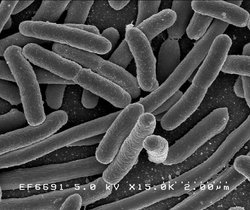Escherichia coli
|
|
| Escherichia coli Conservation status: Secure | ||||||||||||||
|---|---|---|---|---|---|---|---|---|---|---|---|---|---|---|
 | ||||||||||||||
| Scientific classification | ||||||||||||||
| ||||||||||||||
| Binomial name | ||||||||||||||
| Escherichia coli T. Escherich, 1885 |
E_coli_at_10000x.jpg
Escherichia coli (usually abbreviated to E. coli) is one of the main species of bacteria that live in the lower intestines of warm-blooded animals (including birds and mammals) and are necessary for the proper digestion of food. Its presence in groundwater is a common indicator of fecal contamination. ("Enteric" is the adjective that describes organisms that live in the intestines. "Fecal" is the adjective for organisms that live in feces, so it is often a synonym for "enteric.") The name comes from its discoverer, Theodor Escherich. It belongs among the Enterobacteriaceae, and is commonly used as a model organism for bacteria in general.
The number of individual E. coli bacteria in the feces that one human passes in one day averages 1011 to 1013. All the different kinds of fecal coli bacteria and all the very similar bacteria that live in the ground (in soil or decaying plants, of which the most common is Enterobacter aerogenes) are grouped together under the name "coliform" (meaning "like coli") bacteria. Technically, the "coliform group" is defined to be all the aerobic and facultative anaerobic, non-spore-forming, Gram-negative, rod-shaped bacteria that ferment lactose with the production of gas within 48 hours at 35°C (in the body, this gas is released as flatulence).
In the fields of water purification and sewage treatment, E. coli was chosen very early in the development of the technology as an "indicator" of the pollution level of water, meaning the amount of human fecal matter in it, measured using the Coliform Index. The main reasons for using E. coli are that there are a lot more coliforms in human feces than there are pathogens (such as Salmonella typhi, which causes typhoid), and E. coli is usually harmless, so it can't "get loose" in the lab and hurt anyone. It can be misleading to use E. coli as an indicator of human fecal contamination because there are other environments in which E. coli grows well, such as paper mills.
There are, however, three situations where the otherwise harmless E. coli can cause illness:
- When the bacteria get out of the intestinal tract and into the urinary tract, they can cause an infection sometimes referred to as "honeymoon cystitis" because intercourse can lead to introduction of bacteria into the bladder. Although it is more common in females, urinary tract infection is seen in both males and females. It is found in roughly equal proportions in elderly men and women. Since bacteria invariably enter the urinary tract through the urethra, poor toilet hygiene can predispose to infection but other factors are also important (pregnancy in women, prostate enlargement in men) and in many cases the initiating event is unclear.
- When the bacteria get out of the intestinal tract through a perforation (= a hole or tear, which could be caused by an ulcer, for example) and into the abdomen, they usually cause an infection called "peritonitis" that can be fatal. However, E. coli are extremely sensitive to antibiotics such as streptomycin, so treatment with antibiotics is usually effective.
- Certain strains of E.coli are toxigenic (some produce a toxin very similar to that seen in dysentery) and can cause food-poisoning usually associated with eating contaminated meat (contaminated during or shortly after slaughter or during storage or display). Severity of the illness varies considerably; it can, rarely, be fatal, but is more often mild.
Lifecycle_of_e_coli.jpg
A "strain" of E. coli is a family with some particular characteristics that make it recognizable from other E. coli strains, the way poodles are recognizable from other strains (or "breeds") of dogs, and different strains of E. coli live in different kinds of animals, so it is possible to tell whether fecal material in water came from humans or from birds, for example. New strains of E. coli arise all the time from the natural biological process of mutation, and some of those strains have characteristics that can be harmful to a host animal. Although in most healthy adult humans such a strain would probably cause no more than a bout of diarrhea, and might produce no symptom at all, in young children, or in people who are or have recently been sick, or in people taking certain medications, an unfamiliar strain can cause serious illness and even death. A particularly virulent example of such a strain of E. coli is E.coli O157:H7.
Because of its ubiquity, E. coli is frequently studied in cellular biology. Its structure is clear, and it makes for an excellent target for novice and intermediate students of the life sciences.
Trivia
University of Arizona microbiologist Dr. Charles P. Gerba gave his first son the middle name of Escherichia. He told his father-in-law that Escherichia was a king in the Old Testament.
External links
- Encyclopedia of Escherichia coli K12 Genes and Metabolism (http://www.ecocyc.org/)
- The Presence of Coliform Bacteria in Canadian Pulp and Paper Mill Water Systems - a Cause for Concern? (http://www.cciw.ca/wqrjc/35-1/35-1-1.htm) - by Dr. F. Archibald (abstract only)
- Coliform Bacteria and Nitrogen Fixation in Pulp and Paper Mill Effluent Treatment Systems (http://aem.asm.org/cgi/content/full/66/12/5155) - by Dr. F. Archibald (full text)
- Investigation of a UK outbreak by Brian Deer (http://briandeer.com/e-coli-o157.htm)de:Escherichia coli
es:Escherichia coli fr:Escherichia coli nl:Escherichia coli he:Escherichia coli ja:大腸菌 pl:Pałeczka okrężnicy th:Escherichia coli vi:E. coli
